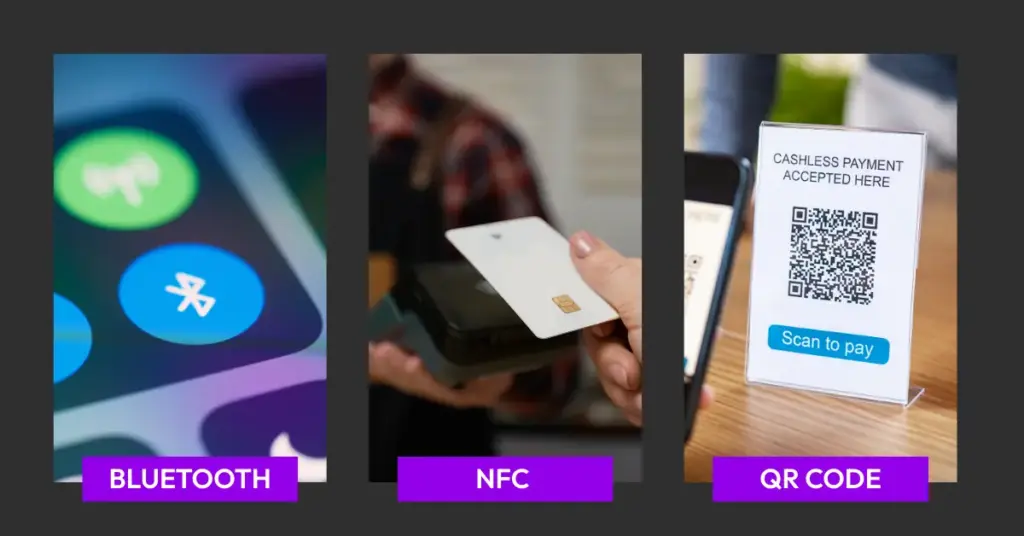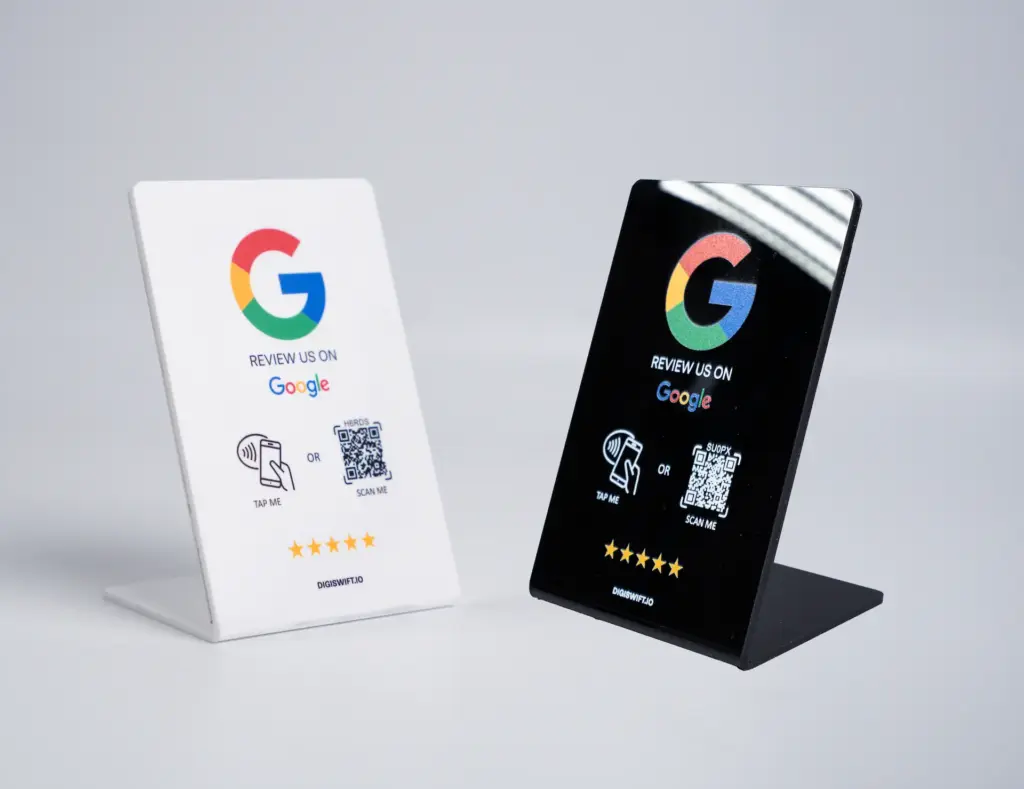Near Field Communication (NFC) technology has become a versatile solution for businesses looking to enhance customer engagement, simplify transactions, and build stronger digital connections. From contactless payments to digital business cards, NFC is transforming how businesses interact with their customers in practical, measurable ways.
With over 2 billion NFC-equipped smartphones now in use globally, this technology has moved from niche innovation to mainstream adoption. Businesses across industries are discovering valuable applications that extend well beyond the familiar payment systems.
In this comprehensive guide, we’ll explore what NFC technology is, how it works, its diverse business applications, and how companies are implementing it to improve customer experiences and operational efficiency.
What is NFC?
Near Field Communication (NFC) is a wireless communication protocol that enables two electronic devices to exchange data when placed within a few centimetres of each other. The technology evolved from Radio-Frequency Identification (RFID) systems but is specifically designed for secure, short-range communication.

The “near field” in NFC refers to the electromagnetic field that forms around the devices when they’re in close proximity. This limited range is not a limitation but rather an intentional security feature, ensuring that communications remain private and targeted.
NFC stands for “Near Field Communication,” a term that accurately describes both its functionality and its primary differentiating feature from other wireless technologies: the requirement for extreme proximity.
Brief History and Development
NFC’s roots trace back to the early 2000s, when Sony, Philips, and Nokia collaborated to develop a standardised technology based on existing RFID principles. The NFC Forum, a non-profit industry association which still exists today, was formed in 2004 to standardise the technology and promote its adoption.
The first NFC-equipped smartphone, the Nokia 6131, was introduced in 2006, but widespread adoption began around 2010 when Google released the Nexus S with built-in NFC capabilities. Apple joined the NFC market in 2014 with the iPhone 6, initially limiting functionality to Apple Pay before gradually expanding access to more features.
Today, NFC has evolved from a niche technology to a standard feature in modern smartphones and an increasingly essential tool for innovative business solutions.
Comparison to Related Technologies
To understand NFC’s unique position in the wireless technology ecosystem, it’s helpful to compare it to similar technologies:
Unlike Bluetooth, which requires pairing and consumes more power, NFC establishes connections instantly with minimal battery impact.
While QR codes serve some similar functions, they require opening a camera app and proper scanning conditions, whereas NFC works with a simple tap, even in poor lighting conditions.

How NFC Works
NFC operates on the principle of electromagnetic induction. When two NFC-enabled devices come into proximity, an electromagnetic field is created. This field allows for the transfer of small amounts of data between the devices without requiring direct physical contact.
The technology uses the 13.56 MHz frequency, with data transfer rates ranging from 106 to 424 kilobits per second. While this is slower than technologies like Wi-Fi or Bluetooth, it’s more than sufficient for the types of quick transactions NFC is designed to handle.
Typical Range and Limitations
One of NFC’s defining characteristics is its intentionally limited range—typically 4 centimetres (about 1.5 inches) or less. This short range is a crucial security feature, making it difficult for unauthorised devices to intercept communications.
This proximity requirement makes NFC ideal for applications where security is paramount, such as payments, access control, and the sharing of sensitive information. The technology is designed to be intuitive, requiring users simply to bring their device near an NFC tag or reader.
Active vs. Passive NFC
NFC operates in two distinct modes:
- Active Mode: Both devices generate their own electromagnetic fields, allowing for two-way communication. This is how two smartphones might exchange contact information or photos.
- Passive Mode: Only one device generates an electromagnetic field, which powers the second device and allows it to transmit data. This is how an NFC tag (which has no power source) can communicate with a smartphone.
Most business applications use passive NFC, where tags or cards are read by powered devices like smartphones. These passive tags can be incredibly small and inexpensive, as they don’t require batteries or maintenance.
NFC Connection Process Explained Simply
The NFC connection process happens in milliseconds and can be broken down into these steps:
- Initialisation: The active device (like a smartphone) generates an electromagnetic field.
- Proximity Detection: When another NFC device enters this field, it’s detected.
- Authentication: If needed, devices establish secure communication protocols.
- Data Exchange: Information is transferred between devices.
- Completion: The connection terminates once the transaction is complete or devices move apart.
This simplicity is key to NFC’s user-friendliness – no complex setup or configuration is required. Users simply tap and go.
Common Business Applications
NFC technology has found its way into numerous business applications, with new use cases continually emerging as the technology becomes more widely adopted.
Customer Reviews and Feedback Collection
One of the most powerful applications for businesses is using NFC to simplify the collection of customer reviews. By embedding NFC tags in signage, receipts, or dedicated cards, businesses can direct customers to their Google Reviews, Trustpilot, or other review platforms with a simple tap.
This dramatically reduces friction in the review process – instead of asking customers to search for your business later or navigate complex URLs, they can leave feedback immediately while their positive experience is still fresh in their minds.

Business Cards and Networking
NFC-enabled business cards are revolutionising professional networking. These smart cards contain embedded NFC chips that, when tapped against a smartphone, instantly share contact information, social media profiles, portfolios, or websites.
This technology eliminates the need for manual data entry, ensures accurate information transfer, and makes a memorable impression on recipients. For businesses, it represents an opportunity to stand out while streamlining connections.
Payment Systems
Perhaps the most widely recognised application of NFC is contactless payments. Systems like Apple Pay, Google Pay, and Samsung Pay use NFC technology to communicate payment information securely from smartphones to point-of-sale terminals.
For businesses, offering NFC payment options speeds up transactions, reduces physical contact (particularly important in a post-pandemic world), and meets growing customer expectations for convenient payment methods.

Marketing Materials
NFC tags embedded in posters, product packaging, or promotional materials can instantly direct customers to websites, videos, special offers, or product information. This creates an interactive experience that bridges physical and digital marketing channels.
Loyalty Programs
NFC technology streamlines loyalty programs by eliminating physical cards and manual tracking. Customers can tap their smartphones to check in, earn points, or redeem rewards, creating a frictionless experience that encourages program participation.
These digital loyalty solutions also provide businesses with valuable data about customer preferences and behaviour, enabling more personalised marketing and service.

Product Authentication
For luxury goods, pharmaceuticals, and other products vulnerable to counterfeiting, NFC tags can serve as secure authentication mechanisms. Customers can tap products with their smartphones to verify authenticity, access certificates of origin, or view product history.
This application not only protects brand integrity but also enhances customer confidence and provides an opportunity for post-purchase engagement.
Benefits Of NFC for Businesses
NFC technology offers multiple advantages that directly impact business outcomes.
Customer Engagement Improvements
By reducing friction in customer interactions, NFC solutions can significantly increase engagement rates. Whether it’s collecting feedback, sharing information, or enabling quick transactions, the tap-and-go simplicity of NFC removes barriers to customer action.
Businesses report that NFC-enabled review collection can increase review submission rates by 200-300% compared to traditional methods, directly impacting online visibility and new customer acquisition.
Data Collection Opportunities
Each NFC interaction creates an opportunity to collect valuable data about customer behaviour, preferences, and patterns. This information can help businesses optimise operations, refine marketing strategies, and personalise customer experiences.
With proper integration, NFC solutions can feed into customer relationship management systems, building richer customer profiles and enabling more targeted engagement.
Marketing Effectiveness
NFC enhances marketing by creating interactive touchpoints that bridge physical and digital channels. This technology turns static displays into gateways for rich content, allows for precise tracking of campaign performance, and enables personalised marketing based on location and context.
The instant gratification of NFC interactions also means marketing messages are delivered at the optimal moment – when customers are actively engaged with your brand.
Brand Perception Advantages
Implementing NFC solutions positions businesses as innovative and customer-focused. The technology creates memorable interactions that differentiate your brand from competitors still relying on older methods.
For businesses targeting younger demographics who expect seamless digital experiences, NFC capabilities signal that a company understands and caters to their preferences.
Conclusion
NFC technology represents a powerful opportunity for businesses to enhance customer interactions, streamline operations, and build stronger digital connections. As smartphone adoption continues to increase and consumer expectations for seamless experiences grow, NFC-enabled solutions will become increasingly essential components of successful business strategies.
The simplicity, security, and versatility of NFC make it uniquely suited to address a wide range of business challenges – from enhancing online presence through reviews to simplifying transactions and building social media following.
Digiswift offers specialised NFC solutions designed specifically for business needs, with pre-configured options for review collection, social media growth, and customer engagement. Our plug-and-play approach eliminates technical barriers, allowing businesses to quickly implement effective NFC strategies without specialised expertise.
Browse our selection of products here or get in touch if you have any questions on how this can work for your business.


